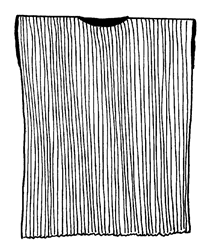Basics
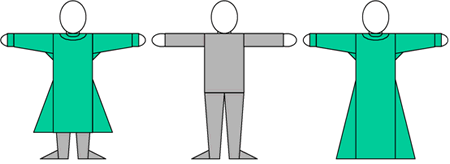
The sleeves are tight on the forearm and baggier on the upper arm. On most garments the sleeves are long enough to reach the knuckles or cover the entire hand.
The upper body of the tunic is relatively close fitting, while the skirt is loose fitting. A tunic should reach to the knees or just below when belted and the dress should cover the ankles (and possibly trail at floor level).
The skirt was made as full as possible by adding panels (or gores) into each side, or as we see later - even into the front and back of the garment.
Bands (or facings) were sometimes added to the cuffs and around the neck; these can be decorated with embroidery or left plain to provide contrast and to protect the large pieces of cloth beneath. Occasionally men's tunics have a wide band indicated around the base of the tunic as well.
New members should start with a very plain tunic - decoration should be limited to applying a facing in a contrasting colour.
Quantity of Cloth
First the cloth - the following assumes that the cloth is about 54-60" (135-150cm) wide - this is the typical width of modern machine made cloth - although the pattern means that you can use cloth from about 24" (60cm) wide - depending on the build of the wearer.
There are two important measurements to take - the chest size (or the belly size if that's bigger) - and then length of the garment. The length of the garment will tell you how much cloth you need. You will need enough cloth to hang over your shoulder to at least mid shin/calf - also remember that the cloth will shrink on washing - so you may want to add 5-10% for shrinkage.
If you want wider side panels or extra panels in the front then you may want to get a bit more.
An example of this is for a man 5'10" (180cm) weighing 14st (90kg) you will need: A piece of cloth about 7½'/2.25m long - the chest measurement is about 44"/110cm round. The sleeves and gores are both about 2'/60cm long and about that at their widest points. A dress for someone of similar size would take about 9'/2.75m long.
The cutting pattern
This is quite simple - so don't panic.
The overall plan for the pieces is shown on the left - you will need to cut one long panel for the body - a single piece of cloth - the width being half the chest width (+ a bit for seam allowance - normally 1"/2cm).
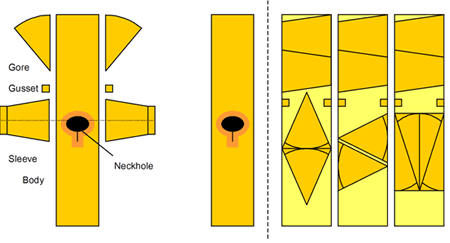
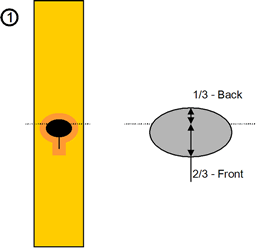
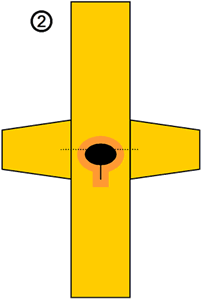
(1) The neck hole is in the middle of the cloth. It is not positioned centrally - it is normally about 2/3 to the front of the body and 1/3 to the rear. The simplest type is a large square or oval - however - wool and linen doesn't stretch like a t-shirt and this will be quite loose at the neck - a 'keyhole' neck with a slit down the front is not that much more complex (see the diagram). It is probably a good idea once this is cut out and hemmed to try it on to see where the middle point actually is (you will need a friend for this probably!) and then to remeasure the lengths (so allow a little extra at each end when you start).
(2) The sleeves are about the same length as the cross chest width (again you can make them slightly longer if you wish. For a male tunic they should extend to the knuckles or even the finger tips). The wrist should be small enough so that the hand will just fit through - but remember - the hem and seam will take up additional space so you will need to allow a bit for this. As guidance - the wrist on the example tunic is 10"/25cm wide and the arm length is 25"/63cm.
Sew the sleeves to the body to form a cross.
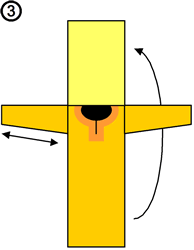
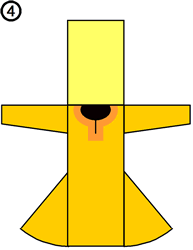
(3) Sew the underside of the sleeves - leaving about 3" (8cm) at the armpit to put in the gusset.
(4) Sew the two gores to the front of the tunic (having sewn them together if they are made from two sections rather than one). They should start from about the top of the hips or just above (in the example tunic they start about 22"/55cm from the shoulder line).
(5) Pin the body together inside out and sew from three inches below the armpit down the side seam and then along back/gore seam.
(6/7) Sew the gusset to the front of the tunic and then to the back.

Now hem the base of the tunic and the cuffs.
Facing can now be added on the neck (and cuffs) (a). More expensive tunics may have a matching wide band of coloured cloth around the bottom. Higher ranking tunics may have tablet weave braid or embroidery around the facings.
Variations
Additional gores can be added to the front of the tunic (don't worry about going exactly up the middle of the tunic - the archaeological evidence seems to indicate that this was not essential - or even the norm!) (b)
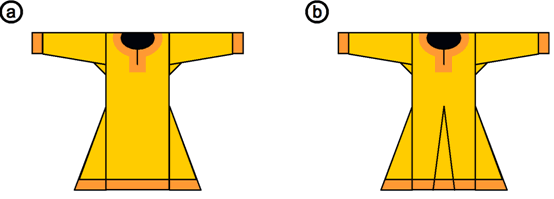
Dresses
Obviously the main difference with the dress is length. Whether or not dresses were belted is open for discussion - they may have even been pulled tight at the waist and tacked into position once on - but the important thing is that they cover the ankles and most of the shoes - possibly even trailing a bit on the floor. Follow the pattern for the tunic - but extend the length of the body and gores.
The more subtle variation is in the gussets under the arms. To make more room for the bust use a diamond shaped gusset (about 4-5" by 7-9") - will allow more freedom at the arms and make the bust a little wider.
Female over dresses throughout Regia's period may have slightly wider sleeves - These sleeves are wrist length and probably 12-15" around at the cuff - they could be cut with a straight forearm.
Undergarments
Undertunics are made from linen or light wool (linen is cooler). Cotton with a 'linen' weave is permissable but not as good as linen - occasionally you will find linen mixes - these again are allowable if linen can not be found.
Undertunics are not shown hanging from under a man's tunic - so the undertunic should be the same size or smaller. Some Regia males wear a short under tunic - about the length of a long shirt. The only problem here is that these garments can not be worn without an overtunic.
The same goes for ladies underdresses; so particularly if you are a cross-dressing combatant - it is possible to get away with your undertunic under an overdress. Also on the subject of cross dressing - some Regia Anglorum members take their dresses and tuck the middle section into their trousers (possibly belting them as well) - which converts the dress into a tunic suitable for combat.
There are two more tunic forms that have not been presented here - the front/back split tunic and the side split tunic - as these are not as common and more importantly cannot be worn for all datelines and should not be your primary choice of tunic. These will be covered in other sections of the members handbook.
You should be told before an event what items of clothing and armour are permissible for that event.
There are two particularly interesting Scandinavian (Viking) underdresses - the kirtle (a shorter sleeved wider body underdress) and the pleated underdress:
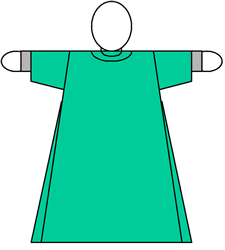
The Kyrtil/Kyrtle (or underdress) was made far baggier than the normal dress. Scandinavian examples sometimes had shorter sleeves. |
It is possible that the cloth was imported in Scandinavia already pleated although the same effect can be obtained by twisting the wet cloth (neck to hem) into a 'rope' and allowing to dry like this. |
Hangerocs
The Hangeroc is a particular style of over dress worn in some Scandinavian countries - they are uncommon in England - and their use certainly died out during the 10th century.
A two piece hangeroc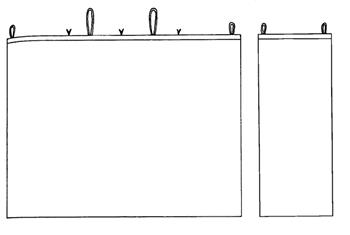
The Vs represent tucks/pleats in the top of the hangeroc to make it fit and hang better - see the illustrations in the next column |
Suspension arrangements 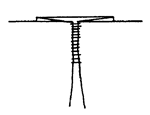 Tuck: Sew down from top edge for about 3″ |
A one piece hangeroc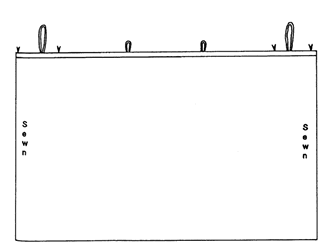 this could be worn with a separate apron like the one piece hangeroc |
Remember that further information can be found in the Regia Library:
- Tunic Pattern (PDF)
